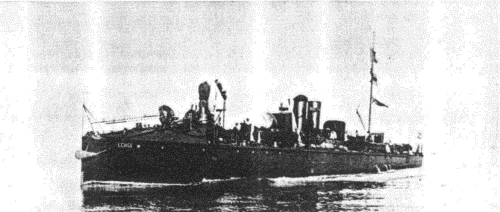
NAVYPEDIA
 Support the project with paypal
Support the project with paypal
Photo

Echse 1910 Many thanks to Wolfgang Stöhr for additional information on this page.
Ships
| Name | No | Yard No | Builder | Laid down | Launched | Comp | Fate |
|---|---|---|---|---|---|---|---|
| Kaiman, 4.1914- 50E | 1172 | Yarrow, Cubitt Town, UK | 10/1904 | 3.6.1905 | 9/1905 | to United Kingdom 1920 | |
| Anaconda, 4.1914- 51T | 354 | STT, San Marco | 10/1905 | 8.5.1906 | 9/1906 | to United Kingdom 1920 | |
| Alligator, 4.1914- 52T | 355 | STT, San Marco | 10/1905 | 30.6.1906 | 12/1906 | wrecked 12.1918 | |
| Krokodil, 4.1914- 53T | 356 | STT, San Marco | 11/1905 | 25.7.1906 | 12/1906 | to United Kingdom 1920 | |
| Wal, 4.1914- 54T | 357 | STT, San Marco | 12/1905 | 10.9.1906 | 6/1907 | to Yugoslavia 1920 (T12) | |
| Seehund, 4.1914- 55T | 358 | STT, San Marco | 12/1905 | 15.9.1906 | 6/1907 | to United Kingdom 1920 | |
| Delphin, 4.1914- 56T | 359 | STT, San Marco | 5/1906 | 29.11.1906 | 6/1907 | to United Kingdom 1920 | |
| Narwal, 4.1914- 57T | 360 | STT, San Marco | 6/1906 | 17.12.1906 | 6/1908 | to United Kingdom 1920 | |
| Hai, 4.1914- 58T | 361 | STT, San Marco | 7/1906 | 24.3.1907 | 6/1908 | to United Kingdom 1920 | |
| Möwe, 4.1914- 59T | 362 | STT, San Marco | 8/1906 | 30.3.1907 | 6/1908 | to United Kingdom 1920 | |
| Schwalbe, 4.1914- 60T | 363 | STT, San Marco | 9/1906 | 8.4.1907 | 3/1909 | to Yugoslavia 1920 (T9) | |
| Pinguin, 4.1914- 61T | 364 | STT, San Marco | 9/1906 | 18.4.1907 | 3/1909 | to Yugoslavia 1920 (T10) | |
| Drache, 4.1914- 62T | 365 | STT, San Marco | 1/1907 | 13.7.1907 | 3/1909 | to United Kingdom 1920 | |
| Greif, 4.1914- 63T | 366 | STT, San Marco | 1/1907 | 8.7.1907 | 3/1909 | to United Kingdom 1920 | |
| Triton, 4.1914- 64F | 1 | Danubius, Fiume | 7/1907 | 18.7.1908 | 12/1908 | to United Kingdom 1920 | |
| Hydra, 4.1914- 65F | 2 | Danubius, Fiume | 7/1907 | 11.10.1908 | 1/1909 | to United Kingdom 1920 | |
| Skorpion, 4.1914- 66F | 3 | Danubius, Fiume | 8/1907 | 15.11.1908 | 1/1909 | to United Kingdom 1920 | |
| Phönix, 4.1914- 67F | 4 | Danubius, Fiume | 1/1908 | 10.1.1909 | 8/1909 | to United Kingdom 1920 | |
| Krake, 4.1914- 68F | 5 | Danubius, Fiume | 6/1908 | 7.2.1909 | 9/1909 | to United Kingdom 1920 | |
| Polyp, 4.1914- 69F | 6 | Danubius, Fiume | 7/1908 | 17.4.1909 | 9/1909 | to Yugoslavia 1920 (T11) | |
| Echse, 4.1914- 70F | 7 | Danubius, Fiume | 10/1908 | 8.5.1909 | 6/1910 | to United Kingdom 1920 | |
| Molch, 4.1914- 71F | 8 | Danubius, Fiume | 11/1908 | 14.7.1909 | 6/1910 | to United Kingdom 1920 | |
| Kormoran, 4.1914- 72F | 9 | Danubius, Fiume | 1/1909 | 31.7.1909 | 3/1910 | to United Kingdom 1920 | |
| Alk, 4.1914- 73F | 10 | Danubius, Fiume | 2/1909 | 2.10.1909 | 6/1910 | to United Kingdom 1920 |
Technical data
| Displacement normal, t | 209 - 211 |
|---|---|
| Displacement full, t | |
| Length, m | 56.0 wl 54.9 pp |
| Breadth, m | 5.50 |
| Draught, m | 1.30 |
| No of shafts | 1 |
| Machinery | 1 VTE, 2 Yarrow boilers |
| Power, h. p. | 3000 |
| Max speed, kts | 26 |
| Fuel, t | coal 47 |
| Endurance, nm(kts) | 1030(16) |
| Armament | 4 x 1 - 47/30 SFK L/33 H, 3 x 1 - 450 TT |
| Complement | 31 |
Standard scale images

Kaiman 1905
Graphics
Project history
After the commissioning of the four Cobra class boats there was a break of four years in Austrian torpedo-boat and destroyer construction. In 1904 a prototype boat was ordered from Yarrow, which was christened Kaiman. Both Stabilimento Tecnico Triestino (representing the Austrian half of the domestic yards) and the new Danubius, Fiume yard (representing the Hungarian part) received British plans and engineering assistance and eventually built 23 units of this class. By an order of 19 November 1913 all torpedo-boats in service gave up 1.1.1914 their names and were given arabic numbers instead. This was carried out by 1 April 1910. Kaiman became Tb 50E (the suffix letter denoting 'England', since she was the Yarrow-built unit) and locally-built boats became Tb 51T - 63T (T denoting Trieste, for the STT-built units) and Tb 64F - 73F (F meaning Fiume, for the Danubius boat). This suffix letter was omitted by the order of 21 May 1917, so from this time on all Austrian torpedo-boats had only numbers. The Kaiman class proved to be a very successful design, all boats seeing extensive active service during World War One.
Modernizations
None.
Naval service
All survived, although some boats were badly damaged after collisions or mining. After the war they were distributed between Great Britain and Yugoslavia, Great Britain scrapping her boats in 1920 in Italy. Yugoslavia kept her boats in service until 1927-28.
Many thanks to Wolfgang Stöhr for additional information on this page.
 HOME
HOME FIGHTING SHIPS OF THE WORLD
FIGHTING SHIPS OF THE WORLD AUSTRIA-HUNGARY
AUSTRIA-HUNGARY TORPEDO SHIPS
TORPEDO SHIPS KAIMAN torpedo boats (1905-1910)
KAIMAN torpedo boats (1905-1910)
